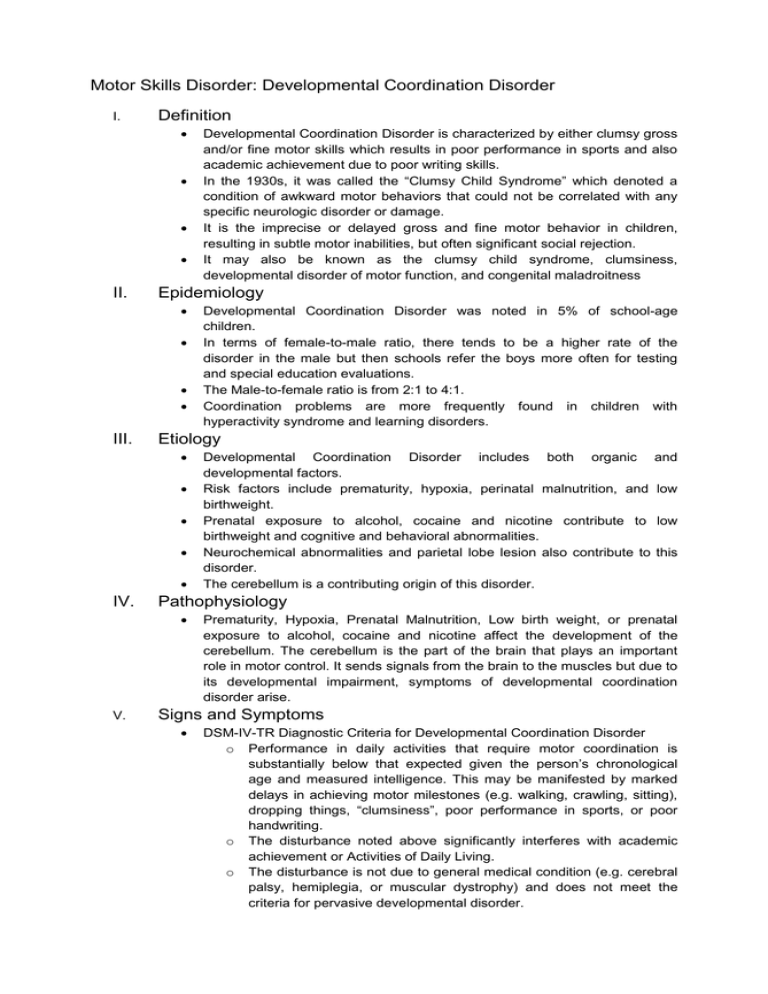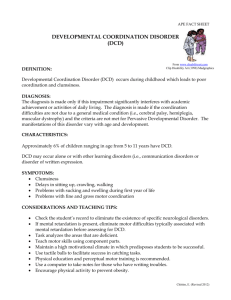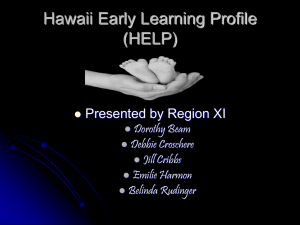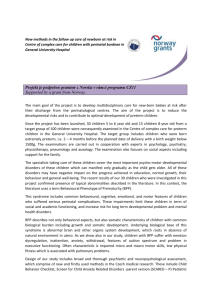Motor Skills Disorder
advertisement

Motor Skills Disorder: Developmental Coordination Disorder I. Definition II. Epidemiology III. Developmental Coordination Disorder includes both organic and developmental factors. Risk factors include prematurity, hypoxia, perinatal malnutrition, and low birthweight. Prenatal exposure to alcohol, cocaine and nicotine contribute to low birthweight and cognitive and behavioral abnormalities. Neurochemical abnormalities and parietal lobe lesion also contribute to this disorder. The cerebellum is a contributing origin of this disorder. Pathophysiology V. Developmental Coordination Disorder was noted in 5% of school-age children. In terms of female-to-male ratio, there tends to be a higher rate of the disorder in the male but then schools refer the boys more often for testing and special education evaluations. The Male-to-female ratio is from 2:1 to 4:1. Coordination problems are more frequently found in children with hyperactivity syndrome and learning disorders. Etiology IV. Developmental Coordination Disorder is characterized by either clumsy gross and/or fine motor skills which results in poor performance in sports and also academic achievement due to poor writing skills. In the 1930s, it was called the “Clumsy Child Syndrome” which denoted a condition of awkward motor behaviors that could not be correlated with any specific neurologic disorder or damage. It is the imprecise or delayed gross and fine motor behavior in children, resulting in subtle motor inabilities, but often significant social rejection. It may also be known as the clumsy child syndrome, clumsiness, developmental disorder of motor function, and congenital maladroitness Prematurity, Hypoxia, Prenatal Malnutrition, Low birth weight, or prenatal exposure to alcohol, cocaine and nicotine affect the development of the cerebellum. The cerebellum is the part of the brain that plays an important role in motor control. It sends signals from the brain to the muscles but due to its developmental impairment, symptoms of developmental coordination disorder arise. Signs and Symptoms DSM-IV-TR Diagnostic Criteria for Developmental Coordination Disorder o Performance in daily activities that require motor coordination is substantially below that expected given the person’s chronological age and measured intelligence. This may be manifested by marked delays in achieving motor milestones (e.g. walking, crawling, sitting), dropping things, “clumsiness”, poor performance in sports, or poor handwriting. o The disturbance noted above significantly interferes with academic achievement or Activities of Daily Living. o The disturbance is not due to general medical condition (e.g. cerebral palsy, hemiplegia, or muscular dystrophy) and does not meet the criteria for pervasive developmental disorder. o VI. Course and Prognosis VII. If mental retardation is present, the motor difficulties are in excess of those usually associated with it. May develop as early as infancy The essential clinical feature is significantly impaired performance in motor coordination. In infancy and early childhood, the disorder may be manifested in developmental motor milestones delay. The affected child can’t hold objects and drop them easily. The gait may be unsteady. They often trip over their own feet. They may bump into other children when attempting to go around them. Older children may have impaired motor coordination in table games. Children affected with this disorder may also have speech and language difficulties and have secondary problems like in academics and have poor peer relationships. Although clumsiness may continue, some can compensate by developing interests in other skills. Some studies suggest a favorable outcome for children who have an average or above-average intellectual capacity since they can find strategies to develop friendships. Clumsiness generally persists into adolescence and adult life. Clumsy children remained less dexterous, showed poor balance and continued to be physically awkward. Those affected were more likely to have academic problems and poor selfesteem. Commonly associated features: delays in nonmotor milestones, expressive language disorder, mixed receptive-expressive language disorder Medical Management Medication has not been indicated for usage in children with DCD however, it has been noted that children with problems in handwriting have improvements in legibility and accuracy with the help of Methylphenidate. Source: Kaplan and Saddock’s Synopsis of Psychiatry 10th edition, Chapter 40, p. 1170-1174 Global Developmental Delay I. Definition It is a significant delay in 2 or more of the following domains: o Gross Motor o Vision and Fine Motor o Speech, Hearing and Language o Personal or Social It is a condition that occurs during the developmental period of a child between birth and 18 years. The child being diagnosed with having a lower intellectual functioning than normal. II. Epidemiology It affects about 1-3% of the population. III. Etiology Chromosomal or Genetic Abnormalities o Down’s Syndrome o Fragile X Syndrome Abnormalities with the structure or development of the brain or Spinal cord o Cerebral Palsy o Spina Bifida Prematurity Infections o Congenital Rubella o Meningitis IV. Pathophysiology Chromosomal, genetic or central nervous system development abnormalities, prematurity or infections can lead to the delays in emergence of developmental milestones. These milestones may emerge later in life and the child has to find coping strategies for the lack of these skills. V. Signs and Symptoms The child is unable to sit on the floor without support by 8 months. The child is unable to crawl by 12 months. The child can’t roll over by 6 months. The child has poor social skills or judgment. The child has problems with communicating. The child has fine or gross motor difficulties. The child uses aggressive behavior as a coping skill. There are delays in oral language development There are memory skills deficits There are difficulties with problem-solving There are delays in the development of adaptive behaviors There are difficulties in learning social rules and lack of social inhibitors. Osteopenia Temper Tantrums Aggressiveness Inappropriate behavior Poor Language skills Concentration problems Poor attention span Impulsiveness Mental Retardation Hyperkeratosis Sweat gland anomalies Melanocyte anomalies VI. Course and Prognosis Once a child is diagnosed and a proper treatment plan is in place, many children are still able to overcome the impact of their developmental delays. Sometimes problems do persist into adulthood, especially if the child has a lifelong disability such as Down’s syndrome. Generally, children who are developmentally delayed can lead independent, productive and full lives as adults. VII. Medical Management Psychiatric drugs to treat behavioral symptoms Source: http://medacad.wikispaces.com/Global+Developmental+Delay http://www.specialeducationalneeds.co.uk/UsefulInformation/TypesofSENDisability/GlobalDevelopmentalDelay.html www.mychildwithoutlimits.org/?page=prognosis







